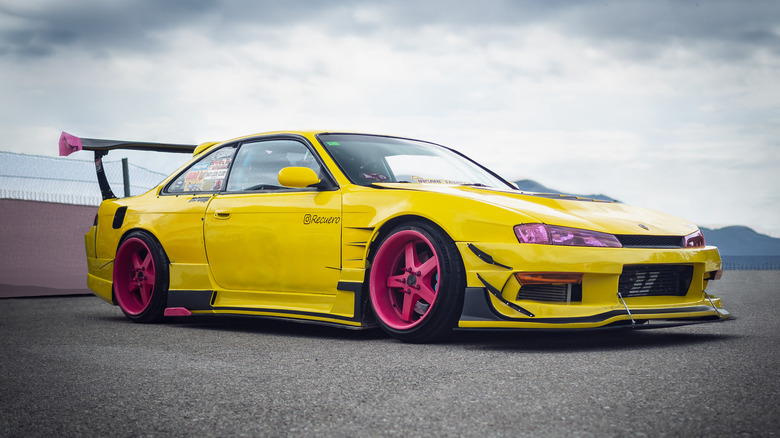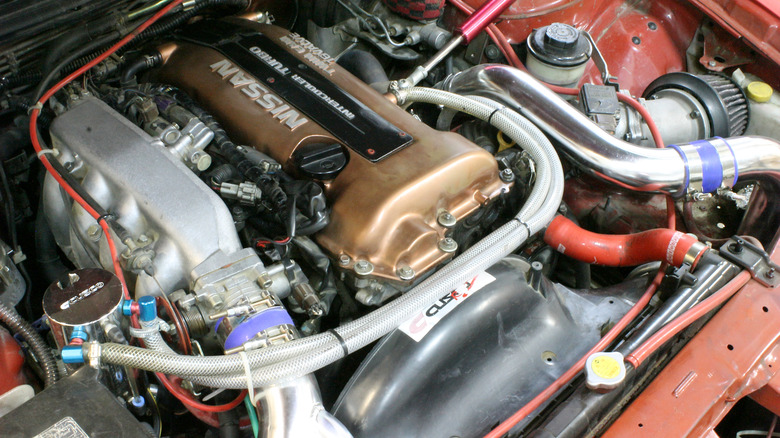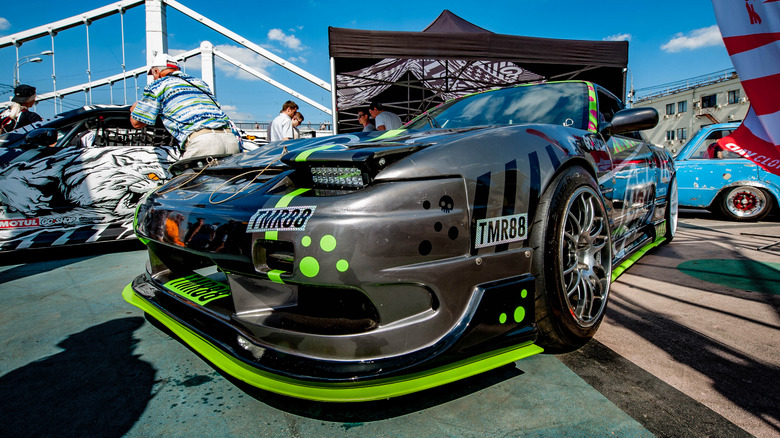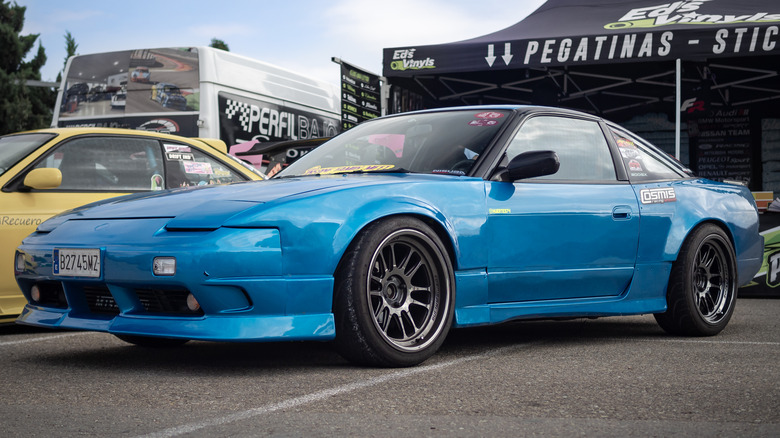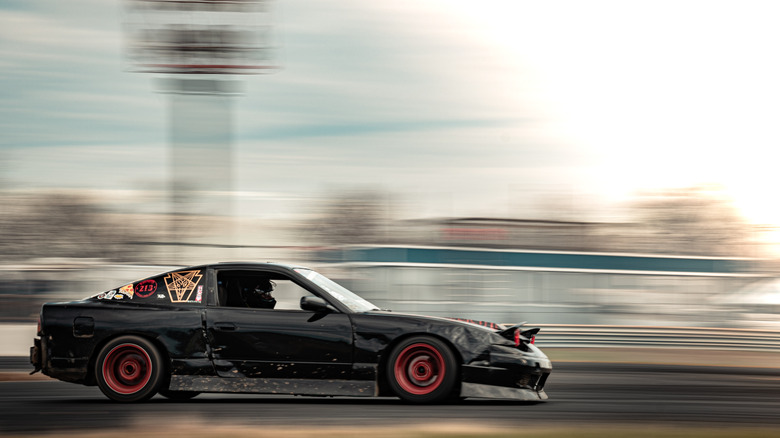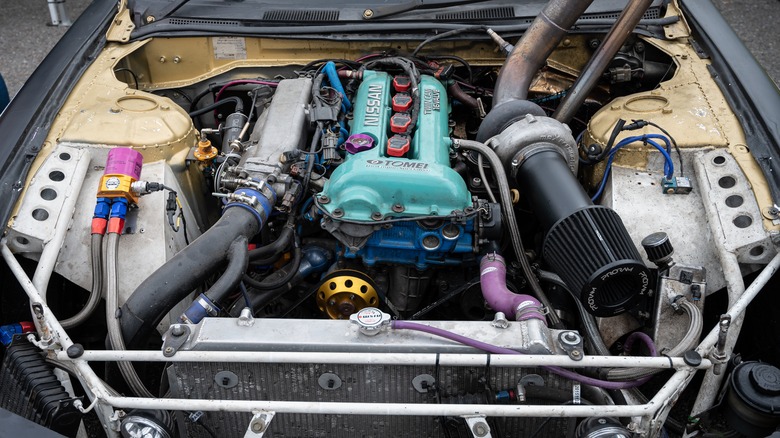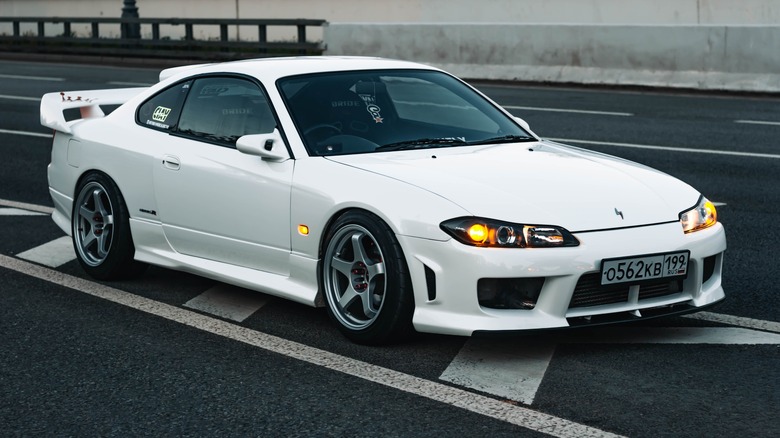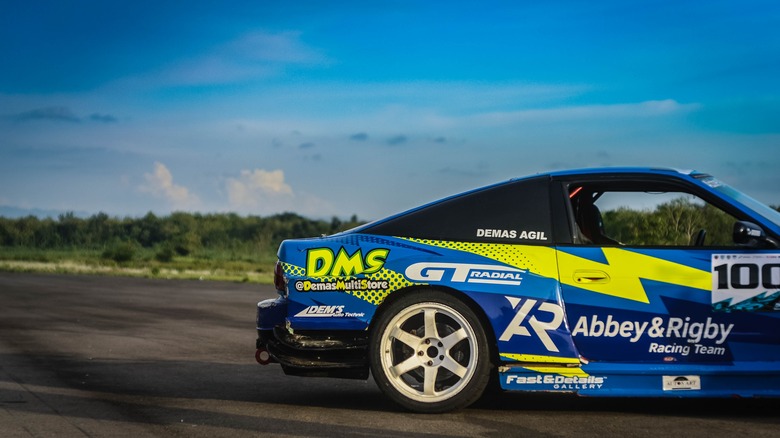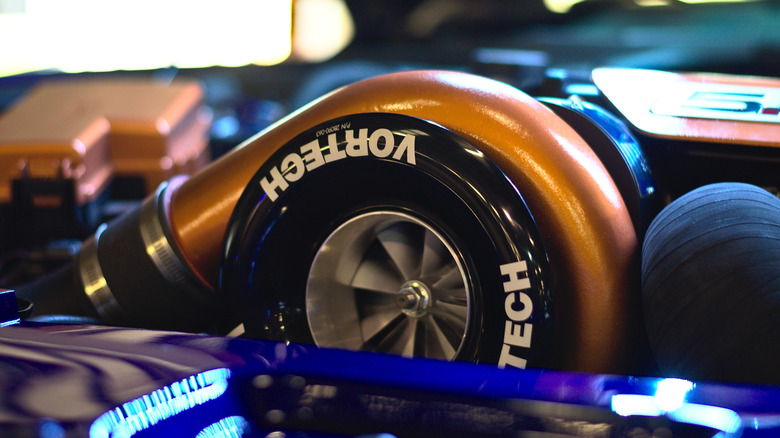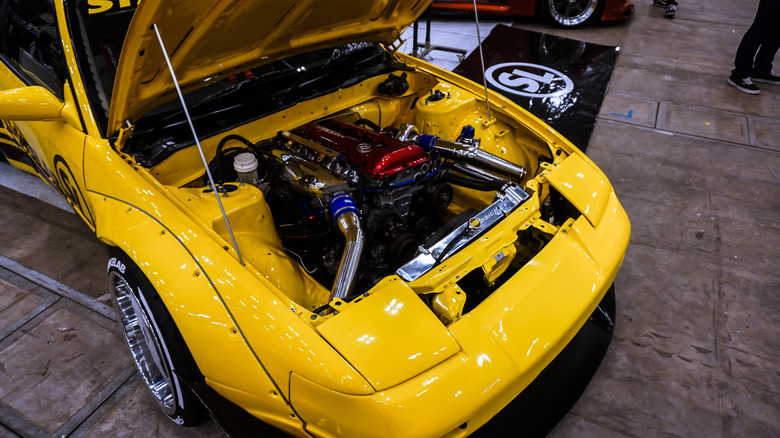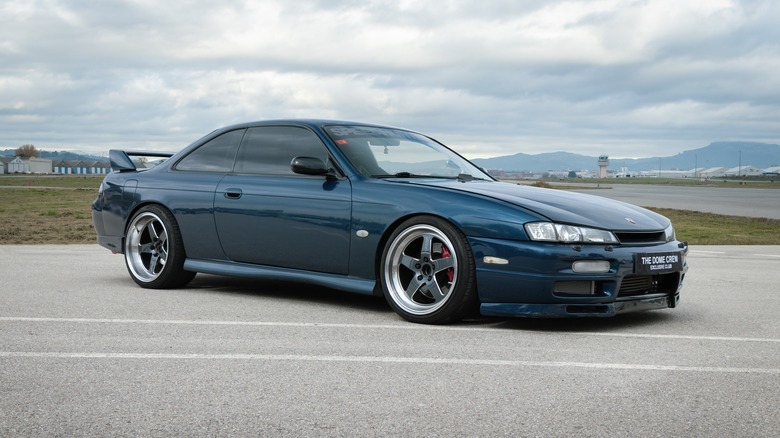10 Things That Made The Nissan 240SX Such An Awesome Drift Car
In a RadVentures interview, filmmaker and former rally driver Ryan Symancek calls a 240SX that's never seen a racetrack a "unicorn." There might be no better affordable platform in motorsports, and there's certainly no better platform for drifting than the 240SX and its even more talented fraternal twin, the JDM 180SX. It turns out that the 240SX (which is the U.S. market version of Japan's 180SX) is so well-suited to drift that it's the first association many make with the car.
Vintage car insurer Hagerty reports that insurance quotes for the car's two generations (1989–1994's S13 and 1994-1998's S4) are tagged "modified" 52% and 62% of the time respectively, compared with 19% for the (1983-1988) 200SX. This is to say, people buy this car for tuning, not for restoration. And those tuners, for the most part, want to go sideways.
What makes a good drift car is something you can generalize about (wide track, wider front track, low stance, long wheelbase, short overall length), depending on who you feel like arguing with, but it's also a matter of collecting all the right pieces and tweaking them perfectly to make a car controllable while pushing it out of control against its will. This is what the 240SX does: it gives you a lot of good pieces as a starting point and makes it pretty easy to get the rest.
1. Its FR Platform
It's handy to start with the obvious, and when it comes to drifting there are obvious advantages to the 240SX's front-engine, rear-drive platform, which was relatively uncommon among Japanese performance cars of the era. Drifting is simply more naturally suited to rear-wheel drive, and while it's possible to drift in a full-wheel drive car, the various techniques amount to something more akin to maintaining a controlled slide. Calling it "lift-off oversteer" doesn't change the fact that you're controlling the drift with brake and handbrake rather than throttle, and the experience isn't as satisfying by most accounts. RWD drifting is where you want to be, even if that means taking on the track in a Ford transit van.
Engine placement is also a big deal. In a June 2020 edition of SportsCar Magazine, North American Touring Car Champion and four-time SCCA World Challenge GT champion Randy Probst explains it with a clear metaphor: a spinning ice skater. Extending your arms in a spin slows the turn while pulling them in close to your center of rotation (like a mid-engine car) speeds up the spin. The trouble is that the mid-engine spins too readily and too fast. You'll hear mid-engine drift cars referred to as "twitchy" or "snappy" for this reason.
The rear-engine car puts weight over the driven wheels, which is desirable in most motorsports contexts but not ideal for drifting — when you want to break the rear tires loose in the corners. And when you do break a rear-engine drift car loose, it can be hard to get back under control.
2. Its ideal weight distribution
Experts, both real and aspirational, will quibble over it, but the 240SX is generally regarded as having a near-perfect weight distribution for drifting, at 55:45, front-to-back. This is especially true of the JDM 180SX with its lighter aluminum engine block. Simply put, the 55:45 split keeps the steering grounded while giving the backend a little room to step out. Sounds like drifting.
How important this is probably varies according to the level of the equipment, driver, and technicians. A non-pro-drift driver is probably going to benefit from a near-equal weight distribution than a professional team with the resources and skill to compensate for minor (or even major imbalances). The potential depth of suspension tweaking is enormous, and much of it can counter any front-to-rear weight distribution imbalance.
Still, as a platform it makes sense to start out as close to neutral as possible, maybe with a touch more weight at the front to bolster steering.
3. Its light weight
You can't have weight distribution without weight, and weight might be the slipperiest of key performance factors for sports cars. At around 2700 lbs., the 240SX is moderately light, as we can see when comparing it to other performance cars of its era and others. Weight can be difficult to wrap your brain around because of the wild variability in numbers you'll encounter. JD Power says the average car in 2022 was 4,094 lbs., for example, but that includes SUVs and the like. The 240SX weighed in at the lower end of the modern compact car weight class, which starts at around 2600 lbs.
Of course, this data point exists in the context of a lot of others, so it's not particularly useful to compare the 240SX to a 2,073-lb. Mirage or a 5,600-lb. Rolls-Royce Phantom. And especially not to a 190 HP, 1,477-lb. Lotus Elise. Whatever Nissan's secret hopes were, the 240SX was a production car built for consumer convenience and comfort, appointed with goodies you won't find on a stripped-down drift car.
Look around at some performance cars of similar vintage vehicles. The Supra was 3,181 lbs. at its lightest, while a 1991 Carrera RS was 2,844 lbs. A 2010 Viper might seem challenged at 3,441 lbs. with a naturally aspirated engine, but it certainly didn't feel challenged. Even a 1995 BMW M3 Lightweight was 2,995 lbs. The Series 7 (Type RZ) RX-7 was closer to a 240SX at 2,800 lbs. The 240SX was pretty light.
4. Its KA24DE (American market) engine
The original engine for the American market S13 240SX was widely panned as an awful piece of machinery. But its 1991 replacement, the KA24DE, quickly gained a reputation for tuner excellence. And the turbocharged version is lauded by some as possibly even better than the JDM engines.
But the KA24E was not an auspicious start. The cast-iron truck engine left sports drivers unimpressed, and it became common to replace it as a matter of course on competitive 240SXs. That engine swap could come in any of a number of flavors, maybe most commonly for minor gains with a CA18DET from the JDM 180SX or for major gains with a GM LS V8.
The KA24DE was also underwhelming in stock form, picking up 15 HP, with peak power at 5600 rpm and peak torque at 160 lb-ft at 4400 RPM. It also kept its cast-iron block, which was heavy but allowed aggressive tuning. Enter the turbocharged KA24DE-T, the label commonly used for a KA24DE with an aftermarket turbocharger. This made 350-400-HP KA24s possible, and it's not hard to find drivers who prefer it to the legendary SR20DET.
5. Its SR20DET (JDM) engine
Whether the KA24DE-T can actually be better than the SR20DET is a matter for people who like a good online fistfight, but there's no question that this JDM monster is a legendary powerplant. To get a handle on it, it's useful to also understand its predecessor, the CA18DET. Even with the Garrett T25 turbo — a key component in some of the best turbo cars ever made – the CA18DET produced 166 HP and 168 lb-ft of torque. Beloved as the CA18DET was from the beginning, it was the SR20DET (and its 1993 revisions) that might have changed the 240SX's fortunes.
The SR20DET was Nissan's four-cylinder legend, with more variations than you can yank a handbrake at. But the legend was, in the end, a concrete and true tale of an all-aluminum block, Garrett T28 turbocharger, under-piston oil sprayers, and precise spark timing. It might have only produced 217 HP, but was readily and frequently tuned to 400 HP, which was plenty. And sometimes tuned to twice that by glorious maniacs.
6. Its S-chassis
However good the 240SX engines were, it was the S-chassis platform that probably made the car an instant classic. It was purpose-built for track days, says Ryan Symancek, and seems like it was purpose-built for drift, eventually becoming the most successful chassis in competition drift history. A "perfect storm" usually describes an accidental confluence of events, so this was more like a perfectly engineered storm. The S-chassis' compactness and driving position were ideal and the low center of gravity and relatively long wheelbase contributed as well, as did other factors.
But the secret sauce was more about commerce than engineering. The S-chassis platform was affordable and plentiful. Whatever a better power-to-weight ratio might have done for the 240SX got accomplished by its price-to-power ratio: far cheaper than most of the cars it passed on track days. There were readily available parts from Nissan (and NISMO) and a healthy aftermarket. And attention to compatibility ensured this advantage did not evaporate. The 240SX was set up to be ubiquitous in motorsport.
And so we come to the "drift tax" — not a tax at all, but the predictable effects on the price of a product with fixed supply and a market that would love to have it back in production. (The 240SX's "Fast and Furious" appearances certainly didn't hurt its popularity). It's difficult to quantify, and there might be no better way to flush out economic illiteracy than by arguing about the drift tax on tuner forums. But if you look at enough examples and counterexamples, what you'll find is that this phenomenon applies to drift and non-drift cars alike as long as there's a strong market for them. It's not a tax and it's not specific to drifting, but it does exist.
7. Its top-tier handling
Most of those qualities of the S-chassis contribute to the world-class handling of the 240SX, among the best-handling production sports cars in spite of its low original price. The credit often goes to the front MacPherson struts and the rear multilink suspension. At a glance, though, MacPherson struts would seem an inferior choice to double-wishbone suspension. Chris Perkins of Road & Track explains why it's reasonable to believe double-wishbones are the better choice for performance cars, and also why it might not be true in any given case.
Perkins makes a similar study of multi-link suspension, observing that the MacPherson front/multi-link rear combination has become so common we don't even think about what they mean anymore. The independence of the 240SX's suspension (versus, say, torsion beam rear suspension) is more modern and upscale than you'd expect from its station and generation, and whatever the peculiarities and causes, everyone agrees that the car handles well.
Perkins' MacPherson strut discussion centers around why a Toyota GR86 handles almost as well as a Miata. Ryan Symancek compares the 240SX's handling to a Subaru BRZ (which is nearly identical to the GR86). But, more importantly, he says the 240SX drives "like a longer Miata." And when it comes to handling, you won't get a better recommendation than that.
8. Its quick-spooling turbos
Reducing turbo lag is an obvious key to performance, and the turbo-equipped 180SX stepped up through increasingly larger and capable Garrett T25/T25G/T28 turbochargers. The T2 series turbos spooled about as fast as anyone could hope to see for the money. The T25 was Garrett's smallest ball-bearing turbocharger and one designed for engines under 270 HP. Ball-bearing turbos have less friction than journal-bearing models, and so can spool as much as 15% faster, from an idle.
The fact that the U.S. Domestic Market 240SX models never came with turbos doesn't matter much. As a 1995 MotorWeek "retro review" feature (shown in the video above) reveals, whatever Nissan's hopes for the JDM 180, the 240SX was being marketed to professional women in the United States, not tuners. So the turbo would have been a peculiar choice for the USDM models. And as we've seen throughout the decades since, bolting on a T25 was never much of an issue for those wanting more horsepower out of a KA24.
Ball-bearing turbos were never universally loved, of course. Patrick James at Pro Systems Turbochargers makes some good points in defense of journal bearing systems, arguing that journal bearings are far easier on turbos and that ball bearings are hardly the best avenue available for eliminating lag in modern turbos. Buy whichever argument, or turbo, you prefer. The point is that the turbo helped make the JDM 240SX something special, and it was possible to make the KA24 models special as well, thanks to a roomy engine compartment.
9. Its excellent tunability
Of course, adding a turbo isn't all the tuning you might want to do in that roomy engine compartment. For less than $6000 you can get upgrade kits specifically for the KA24 engines, including a limited-slip diff, camshafts and valve springs, titanium cat-back exhaust, and upgraded turbo exhaust manifold, and that just scratches the surface. For a clear idea of what the aftermarket looks like at the high end, check out Enjuku Racing's selection or one of several sites devoted to 240SX upgrades.
All of the 240SX engines left room for tuning, especially the CA18DET, from modest improvements like fitting a sports exhaust and remapping the ECU to forged pistons and a stronger gearbox. As a platform, the 240SX is relatively inexpensive to upgrade, parts are mostly easy to source, and the vehicle is easy to work on, even for the novice.
There are a lot of roads you can take to a better 240SX. 180SXClub has a good guide to the CA18DET that breaks down upgrade paths into three stages in order of complexity and invasiveness. It's a good approach: start with the simple, where minor upgrades can sometimes make for noticeable performance increases, and leave the big stuff for some later stage of skill and financial solvency.
10. Its simplicity
Whatever simplicity it is, you know it when you see it. And when you take a wrench to it. Simplicity gives you room to experiment and makes tinkering possible. This is one place where, possibly even more than actually driving, the fun comes in. Looking into an uncluttered engine compartment and dreaming up ways to fit in a top-mount turbo is a whole other layer of fun that simply never ends... at least until you turn pro and hire people to dream up things for you.
As with any car destined to be heavily modified, the big picture is somewhat different from the sum of its parts. Compared with a competitive drift car, the 240SX had a number of shortcomings. Despite hardcore fans' best efforts to convince you otherwise, you might expect to be underwhelmed by a stock 240SX. But modern expectations can be a bit absurd. The 1995 USDM model managed 0-60 in 7.3 seconds and a ¼-mile in 15.5 seconds at 89 mph. But, believe it or not, Chrysler made a turbocharged PT Cruiser model that bested these numbers (0-60 in 6.8 seconds, ¼-mile in 15.4 seconds at 92 mph).
Which would you rather drive? Simple sets of specifications in isolation can mislead you, and it's the whole package that makes the 240SX one of the best drift cars ever – as well as one of the best Nissan vehicles of all time. If you can find one for anywhere near its original lot price, consider buying it. You'll have fun.
